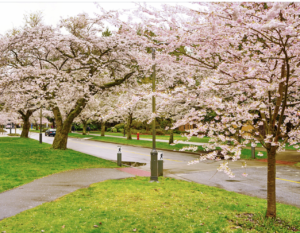Anúncios
The first approved canoe route in southern Scotland launches on the magnificent River Tweed for 30 miles.
Not only does the Tweed flow through the Scottish Borders. The Anglo-Scottish division follows the Tweed for 17 kilometers in its lowest reaches. This has been roughly the case since Malcolm II of Scotland fought Uhtred, the English lord of Bamburgh, at Carham in 1018. Since the 1237 Treaty of York between Henry III of England and Alexander II of Scotland, it has been lawful.
Anúncios
The boundary hasn’t moved much despite battles fought and lost.
“Neidpath is just around this bend,” remarked Craig Kerr, my river guide, as our canoe sped past a sandstone viaduct’s twisted stone arch. Both sides of the river, a patchwork forest of Scots pine, larch, and beech rose steeply. The majestic Neidpath Castle emerged above us as a kingfisher escorted our boat around a river switchback.
Anúncios
I was an hour into the new Tweed Valley Canoe Trail, which opens on 1 May and spans 30 miles of the river from Stobo to Sir Walter Scott’s magnificent mansion at Abbotsford. About 60 miles west of where the river becomes a shared canal, this route flows entirely within Scottish waters. The first waymarked and charted canoe path in southern Scotland winds through a terrain inspired by Scottish history.
Neidpath castle was erected about 1190. Sir Simon Fraser, an early owner, fought with William Wallace and had his skull spiked on London Bridge. The magnificent rubble-built Neidpath tower originates from the late 14th century. It’s known for the “crumbly corner”—one wing’s top stories collapsed during Oliver Cromwell’s 1650 assault and neglect.
The variable Scottish environment is well-documented, yet on rainy days like today, the romanticism of the past appears to spread from the stones.
Go when and how:
Avoid the peak salmon fishing season in October and November by traveling between April and September. At each recommended stop, wooden way markers, anchor points, and informational signs are present. Plan your journey here.
The Borders had about 100 fortified “peel towers” erected as watchtowers, including Neidpath. Like the beacons of Gondor in The Lord of the Rings, additional towers followed a signal fire.
Kerr and I paddled along the Tweed on a day when the water levels were high and the current was like a freeway. Kerr replied, “You can usually duck under these branches,” as we avoided a flooded tree.
The path may be paddled in two or three days by yourself or with a guide like Kerr. I chose the latter on both grounds. Kerr operates Biggar Adventures and has led Tweed trips for over a decade. “Canoeing gives you a new perspective on a familiar landscape,” remarked. “It’s always different.”
Canoeing changes your view of familiar places
We docked at Peebles, a picturesque village, and walked to lunch past a leaping fish sculpture. Outside the ancient County Inn was the town motto, Contra Nando Incrementum (Against the Stream We Multiply). A museum honors Peebles native John Buchan, author of The 39 Steps and former Governor General of Canada. “He was a great fisherman,” said museum volunteer David Brackenridge. “He had a strong connection with the river.”
The whole River Tweed is now a wildlife corridor, not only for salmon. We saw herons, cormorants, and chirping oystercatchers as we paddled downstream. “I once watched an osprey dive down to catch a fish,” he remarked.
Our first route concluded in Innerleithen, an ex-textile town with mountain biking paths and historical sites. After eating and sleeping at the family-run Traquair Arms hotel, I went next door to Durty Brewing to try their beer, named after local bicycle routes. My second day in the canoe was shorter, so I climbed Pirn Hill on the outskirts of town the following morning. A 2,000-year-old fort complex tops the slope. Its center has carved stone panels illustrating the area’s history, from Romans and Celtic monks to Tweed salmon and mills.
Scotland’s oldest home, Traquair, located across the sea. Catherine Maxwell Stuart, 21st Lady of Traquair, and her two lively King Charles spaniels welcomed me over the Tweed Bridge. Traquair House has hosted 27 Scottish kings and queens since 1107.
The Stuarts of Traquair hosted Bonnie Prince Charlie during the 1745 Jacobite insurrection. The prince exited Traquair via the Bear Gates, metal gates guarded by stone bears at the front of the mansion. “The story goes that the Earl of Traquair promised they wouldn’t be opened again until a Stuart king returned to the throne,” claimed Lady Stuart. They’ve been closed since, and the entry is still called “the temporary drive”.
In Traquair, wood carvings, tapestries, and unique Jacobite glasses and wooden stilts used to cross the river when local bridges were few are on display.
In the late 1600s, Traquair estate changed the Tweed by a few hundred meters to protect the house’s foundations. A trapdoor to the canal remains in one of Traquair’s chapels, under a bookshelf in a storeroom. Any resident priest might sail away to the river if a Protestant crowd arrived in an outraged rage, which happened throughout the years.
After walking back to the river, I met Kerr and we paddled past Plora Wood’s natural oak woods, a rarity in the Borders, on stage two of the path. The water on our side made kayaking contemplative and deliberate, with woods, farmlands, and peel tower ruins changing with the river bends.
Near Peel, a little village on the border of Yair Forest with the 500-year-old Glenkinnon Oak, day two finished with wild garlic and daffodils. There are good wild camping areas here, but I found comfort at the neighboring Clovenfords Hotel, guarded by a Sir Walter Scott monument.
We paddled seven kilometers to Scott’s famed country residence on our last day. The day saw rapids, the most spectacular of which occurred under the 1764 stone Fairnilee Bridge. Kerr said, “It’s unlikely we’ll tip over, but we’re definitely going to get wet.” I hardly had time to see the local architecture before the white water struck.
Kerr yelled, “The best thing to do is relax,” as half the Tweed fell on my lap. Our boat kept upright despite our bumps, as promised. We stopped to empty our boat, now a bathtub, laughing. Lilac silver birch, orange larch, and lichen-heavy oaks made for a peaceful last four miles of the path.
The Scots baronial architecture of Abbotsford, a small castle and elegant residence on the Tweed with fairy-tale towers, soon appeared. This sight ended the trek. I explored the historic mansion after climbing out of the boat over Galafoot Bridge.
Sir Walter Scott’s Waverley Novels romanticized Highland vistas and clan causes, changing Scotland’s image. “Scott shattered pretty much every publication record there was to break,” said Abbotsford collections and interpretation manager Kirsty Archer-Thompson.
He was in love with this river and the thought that it represented the Borders. – Kristy Archer-Thompson
The writer and the Tweed had a huge influence on Scotland and Scott. “It was a love affair he had with this river, and with this idea that it encapsulated the Borders,” said Archer-Thompson, adding that Scott helped create the River Tweed Commission, which oversees its health. “It’s part of his legacy that we can enjoy it today.”
I took the train to Edinburgh Waverley, the capital’s main station, from Galashiels, one of the Borders’ largest towns, named after Scott’s novels. From Abbotsford, the Tweed flows east. Cultural tributaries run throughout Scotland before it enters the North Sea. This river defined this ancient country and influenced its present appearance.






